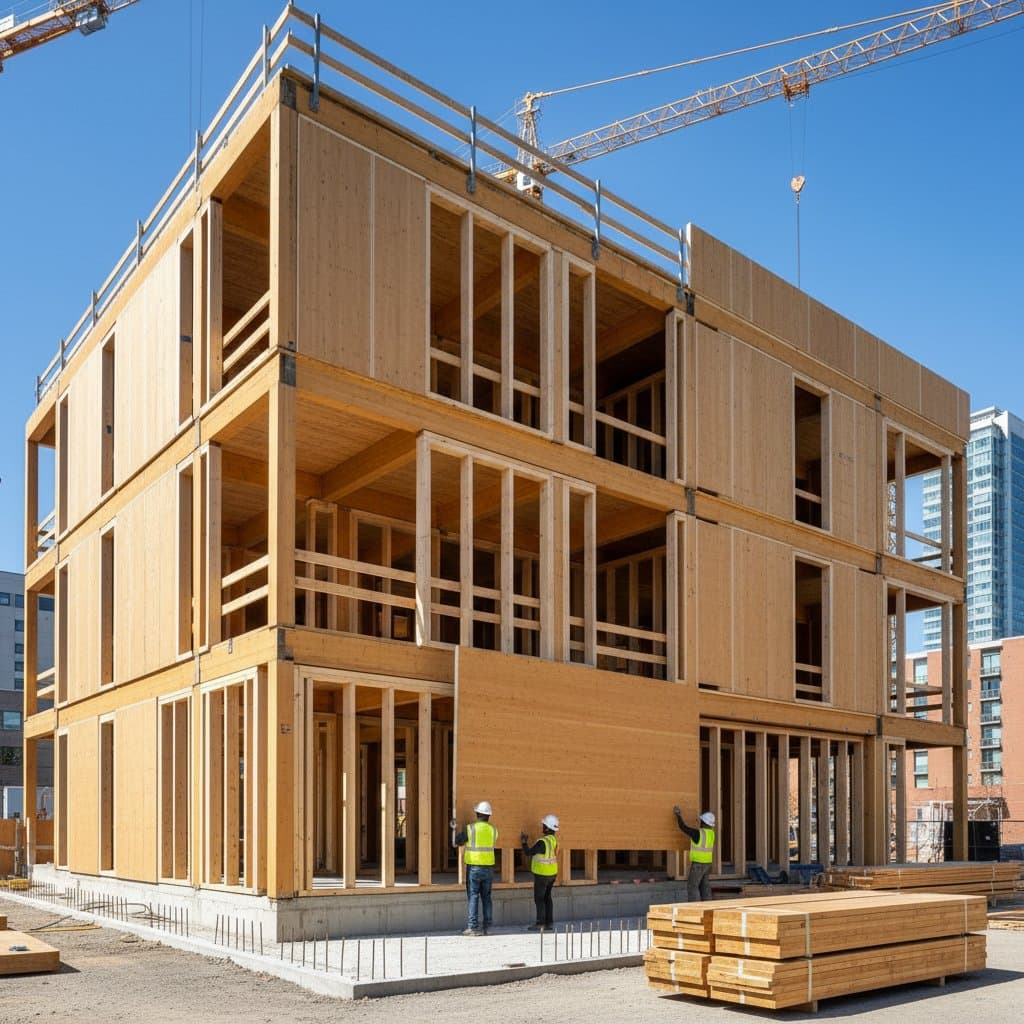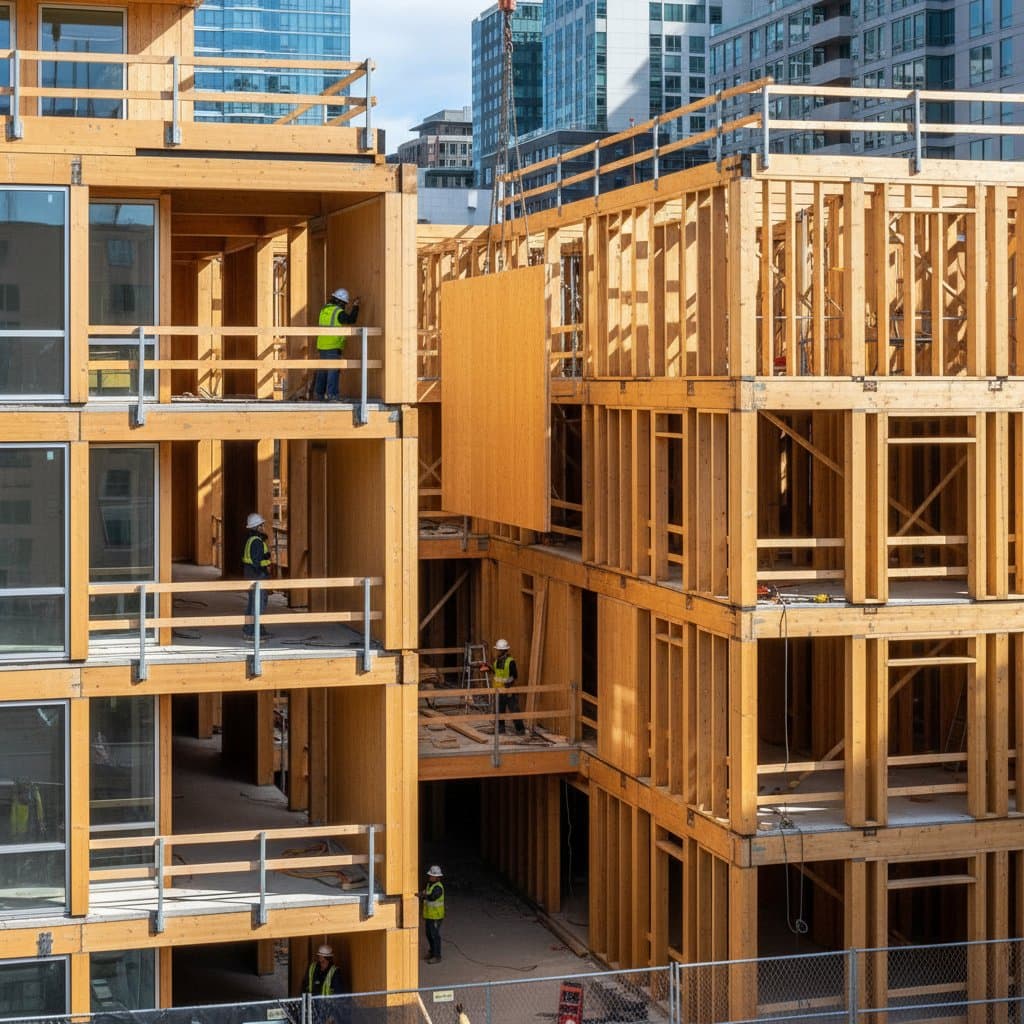2025 Mass Timber Costs: Cheaper Than Traditional Builds?
Mass timber construction has gained attention for its strength, design flexibility, and sustainability. As more projects adopt cross-laminated timber (CLT), glulam beams, and other engineered wood systems, many homeowners and developers want to know how the costs compare to traditional steel or concrete construction. Understanding current pricing helps you plan realistic budgets and evaluate whether mass timber is a cost-effective choice for your next project.
Quick Cost Summary
Mass timber construction typically costs between $250 and $400 per square foot, with most projects averaging around $325 per square foot. Smaller residential builds may fall near the lower end, while large commercial or architecturally complex designs trend higher. For comparison, conventional steel or concrete buildings of similar scale average $300 to $450 per square foot.
Major cost drivers include the type of timber system (CLT, glulam, nail-laminated, or dowel-laminated timber), structural complexity and span requirements, finishing and fire protection methods, availability of local suppliers and skilled labor, and design efficiency and prefabrication level.
While mass timber materials can cost slightly more per unit than steel or concrete, the total project cost often balances out due to faster installation and reduced foundation or labor expenses.
Key Insights
Prefabrication reduces on-site labor time by up to 25 percent, cutting overall costs. Lighter weight means smaller foundations, saving on excavation and concrete. Early design coordination is critical to avoid delays and rework.
Local supply chains improve price stability and reduce delivery time. Code familiarity among engineers and inspectors can influence project cost and schedule.
Cost by Size or Type
The cost of mass timber depends heavily on the structure's size, height, and purpose. Each scale introduces different engineering demands and cost patterns.
Small Residential Builds
Single-family or small multifamily projects using CLT or glulam framing usually range from $250 to $325 per square foot. These builds benefit from reduced framing time and minimal heavy equipment needs. Prefinished panels also limit the need for interior drywall or ceiling finishes, lowering interior fit-out costs.
Mid-Rise Buildings
Mid-rise apartment or office buildings using CLT panels and glulam columns often cost $300 to $375 per square foot. These designs require more coordination between structural engineers and fabricators, but they gain efficiency through repetition of floor systems and prefabricated wall panels.
Large or Complex Structures
High-rise or mixed-use buildings that combine mass timber with concrete cores or steel connections can exceed $400 per square foot. The higher cost reflects custom fabrication, advanced fire protection, and increased engineering oversight. Despite the added expense, developers often recover costs through faster construction and strong tenant demand for sustainable design.
Contractor Costs and Labor Considerations
Labor plays a major role in total mass timber cost. Skilled crews familiar with CLT installation typically charge 10 to 15 percent less labor hours than conventional framing teams, due to the precision and speed of prefabricated systems.
Typical contractor costs include design and coordination at $10 to $25 per square foot, assembly and installation at $40 to $75 per square foot, and site management and logistics at $5 to $15 per square foot.
Contractors often highlight the need for precise scheduling. Since panels arrive ready to install, any site delay can increase crane costs or storage fees. Choosing an experienced builder who understands sequencing and panel handling helps control labor expenses.
Additional Cost Factors
Several secondary costs influence the final price of a mass timber build. Each factor can push the total project cost up or down depending on design choices.
Permits and Code Compliance
Permitting costs vary by jurisdiction. Some areas already have established pathways for CLT or glulam structures, while others require additional engineering review. Expect $3 to $10 per square foot for permit and inspection-related expenses.
Material Sourcing
Material costs depend on proximity to a mass timber manufacturer. Shipping large panels can add $5 to $15 per square foot if sourced from distant suppliers. Using a local or regional fabricator can reduce freight and lower carbon output.
Fire and Acoustic Treatments
To meet building codes, most projects require fire-rated coatings, encapsulation, or acoustic insulation. These treatments add around $10 to $20 per square foot, depending on the required rating and finish quality.
Design Complexity
Curved forms, exposed beams, or hybrid systems with steel connectors add both aesthetic value and engineering cost. Custom details often raise fabrication prices by 10 to 20 percent compared to simple rectangular layouts.
Ways to Save on Mass Timber Construction
While mass timber offers long-term efficiency, several practical strategies keep upfront costs manageable.
- Standardize panel sizes to reduce cutting waste and fabrication time.
- Use modular design for quick installation, lowering crane time and labor.
- Limit custom finishes by choosing a consistent option across floors and ceilings to simplify production.
- Plan early coordination to integrate architectural, structural, and mechanical design and avoid field changes that raise costs.
- Leverage local suppliers to reduce transportation fees and lead times.
- Combine systems strategically, using concrete or steel only where needed, such as stair cores, to balance cost and performance.
Return on Investment
Mass timber buildings often deliver competitive returns through faster occupancy, lower maintenance, and strong tenant interest in sustainable materials. Developers report construction time savings of 15 to 25 percent, translating into earlier rental income or reduced financing costs.
Long-term maintenance costs also tend to be lower. Timber structures resist corrosion and perform well in temperature-regulated environments. When properly sealed and protected from moisture, CLT panels can last as long as traditional materials.
From a resale perspective, buildings featuring exposed timber often command higher valuation due to visual appeal and energy efficiency. Many owners report 5 to 15 percent higher sale prices compared to similar concrete or steel properties.
DIY vs Hiring a Pro
Mass timber construction is not a typical DIY project. The precision required for panel alignment, lifting, and joining demands professional oversight. Even small residential CLT builds require cranes, specialized fastening systems, and coordination with structural engineers.
When DIY Might Work
A homeowner with carpentry experience might handle minor interior finish work, such as sealing exposed beams or installing non-structural timber cladding. These tasks can save a few thousand dollars without affecting structural performance.
When to Hire a Pro
Hire a professional for structural assembly, panel installation, and engineering review. Incorrect installation can cause misalignment or moisture infiltration that compromises safety and durability. Professional crews also manage logistics, such as crane scheduling and fireproof coating application, more efficiently.
Cost Differences
Hiring a professional crew may add $50 to $75 per square foot in labor, but it ensures compliance with building codes and manufacturer warranties. Attempting structural work without certification can lead to costly corrections or insurance issues later.
Cost Methodology
Cost data in this guide comes from recent construction bids, supplier quotes, and contractor surveys across residential, mid-rise, and mixed-use projects. Pricing reflects full project costs, including design, materials, labor, and site management. Ranges account for variations in geographic location, supply chain conditions, and project complexity.
FAQs
How much does mass timber construction cost compared to concrete?
Mass timber usually costs 5 to 10 percent less than concrete when factoring in reduced labor and foundation expenses, even though material prices per cubic foot may be higher.
Is CLT cheaper than steel?
CLT often competes closely with steel framing. It can be cheaper on total project cost due to faster erection and lower labor hours, even if per-unit material cost is comparable.
What influences the price the most?
Design efficiency, local sourcing, and prefabrication level have the greatest influence. Early collaboration among architects, engineers, and contractors controls these variables.
Do mass timber buildings last as long as concrete?
Yes. When properly maintained, mass timber structures can last for decades without strength loss. Protective finishes and good moisture control are key to longevity.
Can I mix mass timber with steel or concrete?
Yes. Many projects use hybrid systems, combining mass timber floors with steel or concrete cores. This approach balances cost, strength, and fire code compliance.
Does mass timber require special maintenance?
Routine inspection for moisture and surface wear is recommended. Most maintenance involves resealing exposed areas every few years to preserve finish and durability.
How long does construction take?
Mass timber projects typically reduce build time by 15 to 25 percent compared to conventional framing due to prefabrication and cleaner installation sequencing.
Are there tax or environmental incentives?
Some regions offer incentives for using sustainable or low-carbon materials. These programs can offset part of the design or permitting cost.
Environmental and Long-Term Benefits
Choosing mass timber also provides measurable environmental advantages. Timber stores carbon, while steel and concrete emit large amounts during production. This difference can reduce a building's embodied carbon footprint by 20 to 40 percent.
Many owners pursue certification programs that reward low-carbon materials, enhancing property value and marketability. Thermal performance is another long-term benefit. Wood naturally insulates, which helps lower heating and cooling costs.
Combined with tight panel joints and integrated insulation layers, energy savings can reach 10 to 15 percent annually compared to conventional envelopes. Acoustics and occupant comfort also improve with mass timber's natural sound absorption and warm interior qualities. These factors contribute to tenant satisfaction and long-term occupancy stability.
Maintaining Your Investment
Protecting a mass timber building requires consistent moisture management. Ensure gutters, flashing, and vapor barriers remain intact. Interior humidity should stay moderate to prevent expansion or cracking.
Regular visual inspections help catch any surface discoloration or sealant wear before damage develops. If panels become scratched or discolored, light sanding and resealing usually restore the surface. Avoid harsh chemicals that could damage finishes.
With proper care, the visual and structural integrity of mass timber remains stable for decades.
Your Next Steps
If you are considering mass timber for a new build, start by connecting with an experienced design team familiar with engineered wood systems. Request detailed cost estimates that separate materials, labor, and logistics. Compare those numbers against local steel or concrete alternatives.
Evaluate not only upfront construction costs but also long-term savings, environmental performance, and project timeline. Mass timber can be an affordable, efficient, and sustainable option when planned carefully. The key to success lies in early coordination, realistic budgeting, and choosing the right professionals.










